Updated Thursday, Dec. 3, 10:52 EST
TAKEAWAY: No respectable interview about the future of our business ends without a question about Augumented Reality. In its December issue, the German magazine de:bug has a special feature on Augmented Reality and hints that “the actual future of print media is the interconnection of Augmented Reality and Paper”. This is my first take on AR, but not the last. Read on.
Time to augment our reality
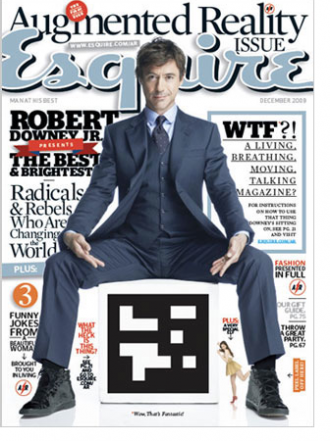
Esquire’s Augumented Reality Cover starring Robert Downey Jr., who introduced the concept to readers
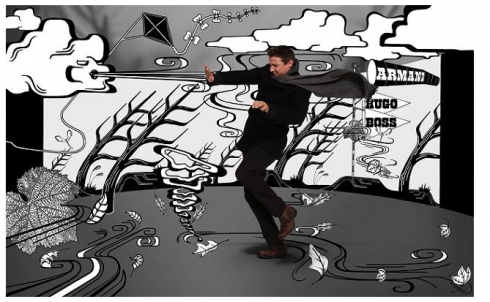
Robert Downey Jr. jumped onto the screen and became real to show Esquire’s first attempt at AR
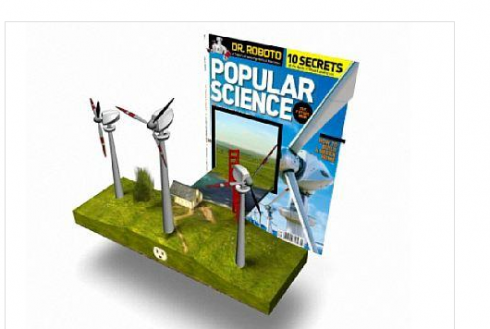
Popular Science: its first Augmented Reality issue came out in July 2009: three dimensional cover
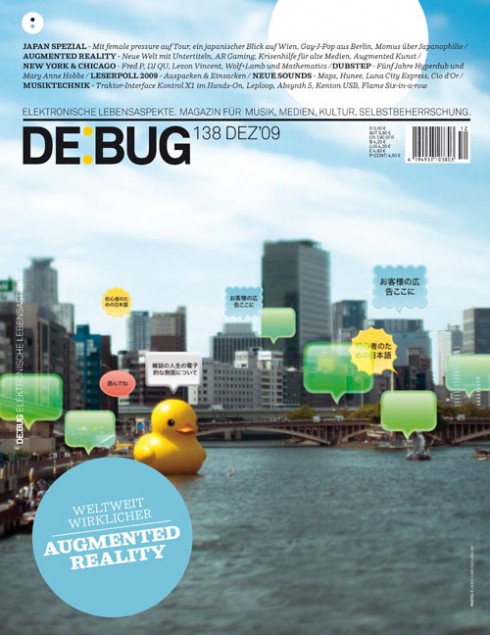
The German magazine de:bug: major splash on Augmented Reality this month with Headline—-Augmented Reality: Larger than Life
The subject is Augmented Reality—-capitalized, in your face, in motion, here now, here to stay and, some say, the next best thing to come to rescue print and pull it out of its bankrupt lethargy.
Augmented Reality makes its presence seen and felt. It lands on the screen with a bang—-as did Robert Downey Jr when he introduced Esquire readers to that magazine’s first experimental issue with AR.
I am as mesmerized with all of it as is everyone else, I guess.
So much so, that I have been Googling my way through countless AR entries, just to see it all explode on my Mac screen. From the way AR works to and to the possibilities that AR could come in as the shining savior of printed newspapers to Esquire’s fantastically impressive first AR issue , and Popular Science, which have pioneered with their AR editions.
Now, the German magazine, de:bug suggests that the imminent future of print is linked to Augmented Reality and the effect it has on readers—-and profits?—-when it lands on a printed page and then jumps to a digital platform.
AR in a nutshell
Augmented reality pulls together multiple layers of data to help present different versions of the real world and allow new ways of interacting with it.
For print utilization, here is how it works: along side an article there is a symbol/bar code that could be scanned by mobile phone, web camera or event an interactive kiosk. Once scanned this would pull up a 3D interactive version of the story that viewers of all ages could manipulate or use to find more information or follow the advertisers’ message. I assume that AR could be one major HOOK to lure those younger readers who don’t remember life without a video game that is where AR was probably first introduced as a technology as long as 20 years ago.
The hook for print publishers is of a different kind: you have to buy the newspaper or magazine in order to flash the codes to your mobile or computer screen before AR becomes a reality.
If you ask me, I think we have had some sort of AR everytime we read bedtime stories to our kids using those “pop up” books which help us make the story more theatrical. With every turn of the page comes a big pop up, the child smiles (pretending to be surprised even after dozens of viewing of the same page), and we adults would find it more interesting than turning the pages of a regular book.
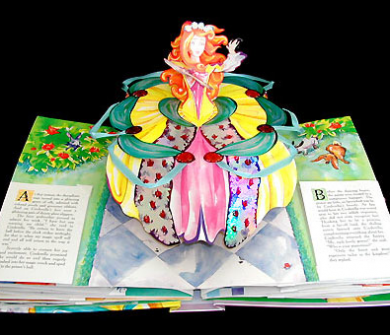
I have seen Cinderella pop out of books hundreds of times, first reading to my daughters then now the granddaughters. Always surprising!
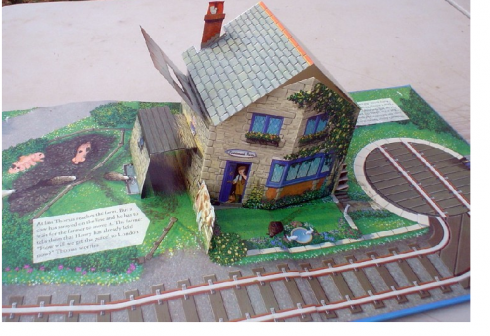
Lately my favorite pop out is about Thomas the Train, which I read to my grandson Frankie Barravecchio everytime I see him
Augmented Reality and the iPhone
Of course, AR is already a nice reality in the iPhone, with more AR applications being developed as we speak.
From TV Guide
How long before the next subway arrives, what is next station?
Zagat Data for the iPhone
Cool! Book a restaurant, see if a table is available, sample the menu, and get there on time.
And one more:
Augumented Reality and Newspaper Advertising
It is in this area that I see great potential for AR. After all, if you can see that new Porsche drive around the screen, park in front of you, doors open and you see the interiors, and maybe smell the leather. Well, you get the picture.
Here is how it worked for a Dutch newspaper advertising sample for Ford automobile:
Augmented Reality and your business card
What could be more excitingly personal than your own AR business card. Depending on your line of work, you can jump right out of your name in sans serif and mesmerize your contacts. Look at Jim Alliban doing it here:
Augumented Reality: only baby steps for now
There is no doubt in my mind that AR offers great potential for print. As we move ever so rapidly into storytelling without limits, and as the technology advances to fit each story with its best possible platform, AR sort of brings it all together.
I was thinking out loud this morning and wondering about AR and its possible applications with fictional works.
I remember reading Gabriel Garcia Marquez’One Hundred Years of Solitude in 1969 and imagining Macondo, that mythical town which emerged from Gabo’s head to land as a million images in the fantasy of every reader of his novel. My Macondo was probably quite different from the one another reader imagined—-not to mention the one that the author himself created in his head. With AR, Macondo would be instantly in view.
I also think that an AR applications for fictional works would make me more eager to abandon the printed book on my night table than, let’s say, a Kindle or any of these other devices which I constantly see but have not been tempted to buy yet.
Augmented Reality and College Texts
Fascinating example from Italy: a student begins reading a book in the traditional way, but the content of the book suddenly comes to live through Augmented Reality.
The AR laboratories
I am fascinated by the thought that, as I write these lines, there are dozens of places globally, where AR artists plan the next step for this marvelous mode of storytelling.
Last week I mentioned my Christmas wish is to layout some Bild Zeitung pages—-to get in the sandbox of those layouters with hundreds of color crayons and give it a try. If Santa is really kind, perhaps I would be doing a Bild Zeitung page with some AR applications——seeing Angelina step out of the People page, followed by Brad, of course; then next to them, Lady Gaga pushing Angelina to the background and singing a few lines of herPaparazzihit; suddenly Penelope, Nicole and Sophia appear triumphant, holding hands and promoting their new movie Nine.
Could Augumented Reality be as good as that scene?
I am sure this is a topic that I will write more about, especially if I get an invitation to participate in some AR experiment related to newspapers.
Storytelling and storytellers never lived in better times.
Augmented Reality of a different kind

These plus-size models will be part of the Glamour calendar
Not necessarily Augumented Reality, but real life plus-sized models appearing in Glamour magazine. Ever since Glamour first introduced its full figure beautiful models, the trend has paid dividends for the magazine, reports Lucia Moses. “The Condé Nast title caused a sensation when it featured two photos of plus-sized models in recent issues. Now, editor Cindi Leive has used one of those photos (above) in the magazine’s first calendar. The “Inspiration” calendar is being bundled with a subscription offer on Glamour.com. It’s not quite Calendar Girls, the calendar featuring nude British ladies and strategically placed flowerpots and teacups that inspired a 2003 movie by the same name. But it’s nonetheless a reminder that beauty comes in all shapes and sizes.”
Sorry, guys, this is still not an Augumented Reality issues, so don’t expect the models to jump on your screen and introduce themselves.

New pages from Thailand’s The Nation
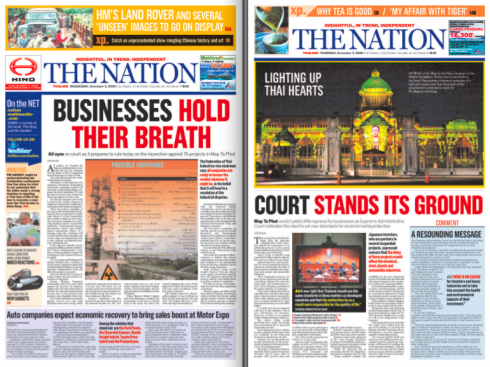
Two recent front pages from Thailand’s The Nation, which reverted to a general interest newspaper format Dec. 1
In our blog post Monday we discussed The Nation’s return to its original general interest newspaper concept, which the Thai daily had abandoned in early 2008 when it became a business/politics emphasis newspaper
Design director Leroy Sylk sends us the latest pages printed since the Dec. 1 conversion to general interest newspaper for The Nation.
Leroy agrees that from a design and readers point of view, Daily Xpress was a success.” The readers really liked it, and hopefully it should make a return sometime in the future when things look up,” says Leroy.
How about reaction to the Nation returning to its roots as a general interest daily after not even two years as business/politics newspaper?
From the initial feedback, the readers like our new Nation—both the design and the content, so that’s heartening. The A1 design is flexible, and as we go along we’ll be using each day the different design elements I had designed. My aim is to surprise the reader EVERY morning with different design treatment and fresh, interesting content.
Want to design the SND 31st edition book cover?
The Society for News Design is offering designers this opportunity for the fourth consecutive time. A panel of 12 judges will begin reviewing cover entries soon after the competition¹s Dec. 18 deadline. Judges are expected
to begin their cover reviews by Dec. 20 with the winner selected in early
January 2010.
The winning cover will appear on the book that showcases winners from the
2009 publishing year. Covers concepts must be 9 inches wide x 12 inches. An
additional .25-inch is required for any side that will bleed beyond the trim
size.
Designers are asked to submit high-resolution (300 dpi at full size) jpg,
tiff or PDF files. It¹s recommended that the name of the book – The Best of
News Design – appears on the cover as well as the name of the
organizations, which may appear near the bottom of the cover, at the
designer¹s discretion. Also the book¹s edition number has appeared on most
past covers. The cover is normally printed in full color.
Send entries to Marshall Matlock at cmm@dreamscape.com.
Send questions and cover entries to cmm@dreamscape.com.
TheMarioBlog post #430